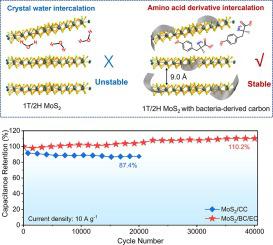当前位置:
X-MOL 学术
›
Chem. Eng. J.
›
论文详情
Our official English website, www.x-mol.net, welcomes your
feedback! (Note: you will need to create a separate account there.)
1T/2H Mixed-phase MoS2 with enlarged interlayer spacing induced via bacteria-derived carbon for long-lifespan pseudocapacitors
Chemical Engineering Journal ( IF 13.3 ) Pub Date : 2024-05-07 , DOI: 10.1016/j.cej.2024.151934
Zicheng Cai , Yunan Wang , Jing Zhao , Qian Long , Shuangwen Li , Di Guo , Zhengwang Zhu , Haifeng Zhang
Chemical Engineering Journal ( IF 13.3 ) Pub Date : 2024-05-07 , DOI: 10.1016/j.cej.2024.151934
Zicheng Cai , Yunan Wang , Jing Zhao , Qian Long , Shuangwen Li , Di Guo , Zhengwang Zhu , Haifeng Zhang

|
Pseudocapacitors (PCs) are considered prospective candidates for large-scale aqueous energy storage systems due to their high power density. However, the poor cycling stability resulting from sluggish metal ion transport kinetics and the instability of the electrode structure hinders their further applications. To address this issue, an effective strategy of 1T/2H mixed-phase MoS2 directly grown on the electrochemically activated carbon (EC) induced via bacteria-derived carbon (BC) from bacillus subtilis is proposed to achieve efficient anodes for potassium ion capacitors. The inherent nitrogen elements found in the bacteria-derived carbon, along with a trace amount of amines and their derivatives generated from amino acid decarboxylation, act as support by inserting into the MoS2 interlayer. Amines and their derivatives as intercalators could suppress the MoS2 layer stacking and mitigate structure damage, which is responsible for preventing rapid capacity fading. Thus, the mixed-phase MoS2 with an expanded interlayer spacing of 0.94 nm achieves a remarkable durability with a capacitance retention of 110.2 % after 40,000 cycles at 10 A g−1 . Density Functional Theory (DFT) reveals that the mixed-phase MoS2 could improve electron transfer ability and cyclic stability, in which the rich vacancies introduced by bacteria-derived carbon could enhance the K+ adsorption. To highlight, the asymmetric capacitor device (ASC) adopting mixed-phase MoS2 anode shows a long lifespan (88 % capacitance retention over 10,000 cycles). This work will provide a green approach to boost cycling performance of MoS2 anodes and shed light on developing high-performance MoS2 -based materials for electrochemical energy storage.
中文翻译:

通过细菌衍生的碳诱导具有扩大层间距的1T/2H混合相MoS2,用于长寿命赝电容器
赝电容器(PC)由于其高功率密度而被认为是大规模水储能系统的潜在候选者。然而,金属离子传输动力学缓慢导致的循环稳定性差以及电极结构的不稳定性阻碍了它们的进一步应用。为了解决这个问题,提出了一种有效的策略,即直接在枯草芽孢杆菌细菌衍生碳(BC)诱导的电化学活性炭(EC)上生长1T/2H混合相MoS2,以实现钾离子电容器的高效阳极。在细菌衍生的碳中发现的固有氮元素,以及氨基酸脱羧产生的微量胺及其衍生物,通过插入MoS2夹层充当支撑物。胺及其衍生物作为嵌入剂可以抑制 MoS2 层堆积并减轻结构损坏,从而防止容量快速衰减。因此,层间距扩大到0.94 nm的混合相MoS2在10 A g−1下循环40,000次后实现了显着的耐久性,电容保持率为110.2%。密度泛函理论(DFT)表明,混合相MoS2可以提高电子传递能力和循环稳定性,其中细菌来源的碳引入的丰富空位可以增强K+吸附。值得强调的是,采用混合相 MoS2 阳极的不对称电容器装置 (ASC) 具有较长的使用寿命(10,000 次循环后电容保持率为 88%)。这项工作将为提高MoS2阳极的循环性能提供一种绿色方法,并为开发用于电化学储能的高性能MoS2基材料提供线索。
更新日期:2024-05-07
中文翻译:

通过细菌衍生的碳诱导具有扩大层间距的1T/2H混合相MoS2,用于长寿命赝电容器
赝电容器(PC)由于其高功率密度而被认为是大规模水储能系统的潜在候选者。然而,金属离子传输动力学缓慢导致的循环稳定性差以及电极结构的不稳定性阻碍了它们的进一步应用。为了解决这个问题,提出了一种有效的策略,即直接在枯草芽孢杆菌细菌衍生碳(BC)诱导的电化学活性炭(EC)上生长1T/2H混合相MoS2,以实现钾离子电容器的高效阳极。在细菌衍生的碳中发现的固有氮元素,以及氨基酸脱羧产生的微量胺及其衍生物,通过插入MoS2夹层充当支撑物。胺及其衍生物作为嵌入剂可以抑制 MoS2 层堆积并减轻结构损坏,从而防止容量快速衰减。因此,层间距扩大到0.94 nm的混合相MoS2在10 A g−1下循环40,000次后实现了显着的耐久性,电容保持率为110.2%。密度泛函理论(DFT)表明,混合相MoS2可以提高电子传递能力和循环稳定性,其中细菌来源的碳引入的丰富空位可以增强K+吸附。值得强调的是,采用混合相 MoS2 阳极的不对称电容器装置 (ASC) 具有较长的使用寿命(10,000 次循环后电容保持率为 88%)。这项工作将为提高MoS2阳极的循环性能提供一种绿色方法,并为开发用于电化学储能的高性能MoS2基材料提供线索。

































 京公网安备 11010802027423号
京公网安备 11010802027423号